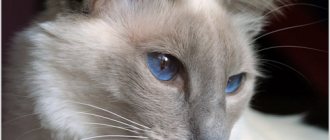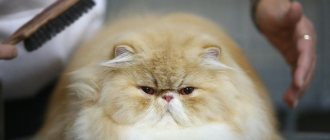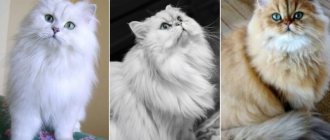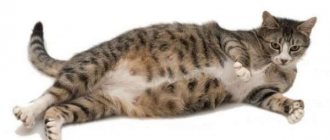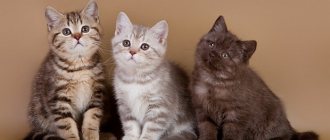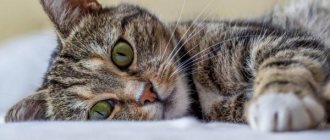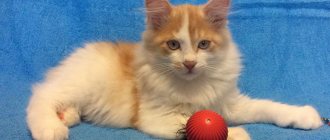History of the Persian cat breed
There are several versions of the origin of Persian cats.
Persian cat
According to one of them, the first long-haired animals were brought to Europe in the twenties of the 17th century by the Italian aristocrat Pietro della Valle from his trip to Turkey and Persia. In the city of Isfahan, he acquired several pairs of amazing and unusual animals for Europe at that time and sent them to Italy. Unfortunately, nothing is known about the further fate of these animals. And who knows how the history of the Persians would have developed further if the French scientist Nicole-Claude Farbi, who corresponded with della Valle, had not turned out to be a true cat lover. Having become interested in the breed described by the Italian and previously unseen in the Old World, he brought several Turkish Angora cats to France. Luxurious long-haired beauties won the hearts of the European aristocracy, including the all-powerful Cardinal Richelieu. With such patrons, the new breed has become one of the most elite. Owning an oriental cat has become not only fashionable, but also prestigious. Depending on where they were brought from, furry pets in those days were called Turkish, Asian, Russian, and even Chinese. Bearing in mind that the Persians began their spread throughout Europe from France, for some time they were called French cats.
According to another version, long-haired animals originally appeared on the territory of Russia, where the presence of such a coat was due to harsh climatic conditions. It was from here that these strange animals came to the East, and only later, in the 17th century, did Europeans first learn about them.
The scientific literature of the late 18th century describes two main types of long-haired cats. The first is that the animals are light, graceful, with thin soft fur, a wedge-shaped head and pointed ears. The second is more massive, round-headed and short individuals with long hair and the presence of a thick undercoat.
Persian kitten
Soon the new breed came to England. British felinologists have found sufficient grounds to divide long-haired cats into two breeds depending on their type. The first began to be classified as Turkish Angoras, and the second were called at first French and then Persian cats. The interest in long-haired pets and their breeding was so great that Persians were registered in 1887. They were one of the first among other domestic cats to gain official status. The breed was called "Persian Longhair".
A new stage in the development of the breed began at the end of the 19th century, when the Persians came to the United States. American breeders have put a lot of effort into changing the classic British version of the cat's appearance, and have been quite successful in this. A new “extreme” type appeared, which was characterized by the unusual appearance of the animal’s muzzle: an extremely short nose with a high stop, an overhanging forehead, pronounced folds from the corners of the eyes to the mouth, and widely spaced eyes. This unusual exterior attracted cat lovers, but it also caused multiple animal health problems. Only hard work made it possible to minimize the negative results of selection experiments. Extreme Persians are very popular today, and many consider them to be the real representatives of the breed. This is not entirely fair. There are many clubs in the world for Persian cat lovers who prefer breeding the classic type.
Interesting facts about the breed
The Persian cat breed differs from other breeds not only in appearance, but in the history of their development there are many interesting facts.
- Back in 1901, the first club of blue Persian cat lovers was created in Great Britain, where at first only blue-eyed specimens were recognized, but then yellow-eyed ones were also included in the standard.
- In the USA, since 1935, breeders began to breed long-haired Persian colorpoints. The first kitten with the nickname Debutant marked the beginning of the breed of cats with a Siamese pattern, but similar to the Persians.
- Persian cats were the favorites of Queen Victoria, who was inseparable from them. Following her, all the court ladies acquired blue Persians.
- Snow-white cats with blue eyes are often susceptible to a genetic disease. They are more likely to be deaf from birth.
- Chinchilla cats have a defect in the form of a short tongue, so they do not lick themselves.
- Persians are different from other cats in that they love grooming and take great pleasure in being brushed.
Of all the variety of amazing cat breeds that exist, many people around the world prefer the cute snub-nosed Persians.
Appearance of a Persian cat
The size of the animal is medium to large. Weight – from 3.5 to 7 kilograms.
Head
Fluffy handsome man
Large, with a convex dome-shaped skull. The cheekbones are powerful, the cheeks are thick and round. The stop is clearly defined. The nose is very short and wide, often upturned. Persian cats of the “Pekingese” type have a small and depressed nose. The muzzle is wide and round. The jaws are well developed, the chin is weak.
Eyes
Large, round, as if wide open. Widely located. The eye color must correspond to a certain color. For chinchillas, silver and golden individuals - a green tint, a blue iris is typical for color points. The combination of light blue eyes + white color is highly valued. Copper and orange tones correspond to the standard for a Persian of any color. White Persian cats can have different colored eyes (one is light blue, the other is orange).
Ears
The ears of Persian cats are relatively small and widely spaced. The tips are rounded, the inside of the auricle is well pubescent.
Neck
Thick with well-developed muscles, short.
Persian cat face
Body
Quite large, muscular, massive. The chest is deep and wide, the back is wide and short. The width of the shoulders and croup are almost the same. The bones are strong.
Legs
Short, powerful, with well-developed muscles. The bone is straight.
Paws
Strong, rounded, wide. Long hair between toes.
Tail
Persian tortoiseshell cat
The tail of the Persian cat is short and thick in proportion to the body with a rounded tip. Very well dropped.
Wool
The Persian coat is long, up to 10 cm on the body and up to 20 cm on the collar, soft and delicate to the touch. The undercoat is thick.
Color
The breed standard allows any color option. The classic types of color include solid (without stripes or patterns); tortoiseshell (in cats); “smoke” when the outermost part of the hair is white (the ideal proportion is 1/3 – white, 2/3 – colored); two-color, silver, golden, chinchilla, color point, seal point, layack point, blue point, tabby (marble, brindle or spotted).
Disadvantages of the breed
An elongated narrow head, large pointed and close-set ears, a long nose. Small slanted eyes. Long body, legs and tail. Oval paws and long toes.
Disqualifying signs for Persian cats are a knobby tail, poorly developed jaws with pronounced defects, and “medallions” on the chest.
Striped (tabby) colors
The group of “tabby” suits is divided into the following colors:
- Silver - silvery.
- Blue-Silver - blue silver.
- Red - red.
- Brown - brown.
- Blue - blue.
- Cream - creamy, filling.
- Cameo - cameo.
- Cameo-Cream - creamy cameo.
The striped color itself is divided into three varieties:
- Classic - classic: bull's-eye stripes running down the sides.
- Mackerel - “mackerel”: narrow lines and stripes.
- Patched - “patches”: a combination of classic o. This color is not allowed for red, cream and cameo.
In Tabby Persians you will see coppery, orange eyes. The exception is silver and blue silver suits: they have green or brown irises. Their coloring is very bright, which makes the Persian look like an exotic jungle cat. The striped markings on the face add additional attractiveness.
Photo of a Persian cat
Personality of the Persian cat
The Persian cat has a surprisingly calm, friendly and balanced character.
The psychological peculiarity of Persians is that they are very afraid of upsetting their owner: after all, they are purely domestic cats, very attached to humans and determined to give him joy and pleasure. Even if you accidentally offended a Persian cat, she will not “sulk” for long and will gladly accept all your apologies. There is one nuance: at first Persians are afraid to sit in a person’s arms. Therefore, under no circumstances should you hold them if they break out. The cat must get used to the person.
Representatives of this breed are inactive, even somewhat lazy. Persian cats hardly even meow; to attract attention, they simply sit next to them and gaze intently into the eyes of the object. They like to lie in one place for a long time, so the questions “where is the cat now and what is she doing” will not bother you. But if you offer your pet to play with a ball or chase an artificial mouse, he will never refuse.
Lazy and furry homebody
The Persian, unlike other breeds, cannot be called a cat that walks on its own. They are big homebodies who love their owner and appreciate comfort. They are not interested in walking outside, but lying on the windowsill and watching the world around them is their favorite pastime, so if you live on high floors, consider precautions so that your pet does not reflexively jump after a bird flying past.
It is not difficult for a Persian cat to establish contact with dogs; pet parrots and canaries are completely safe in the company of a Persian - even outside the cage. The heart of the Persians is open to everyone. True, they treat strangers with suspicion, but only at first, after closer acquaintance, they will be as friendly as with others.
Mother cats are very caring and take excellent care of their kittens, while they are absolutely not jealous of them and do not show any aggression towards others.
Due to its character, the Persian cat is ideal for both a single person and a large family, where there are not only small children, but also pets of other species.
Origin story
Exotics appeared in the 50s of the last century in the USA as a result of a not entirely successful experiment to improve the American Shorthair breed as a result of crossing a cat of this breed with a Persian. This experiment was conducted without the approval of the CVA Board of Directors. It was decided to separate hybrids into a separate breed only in 1966 at the suggestion of Jane Martink.
Representatives of the Burmese cat and Russian Blue were used in the selection of the breed. The experiments were stopped only after the shorthair gene was firmly established in the breed. Matings of exotics have since been allowed only with Persians.
Upbringing
Persian cats are very smart and vulnerable creatures. When raising a kitten, do not show impatience or aggression under any circumstances. Loud screaming and noise when communicating with the baby are also unacceptable. Methods of physical pressure have a particularly painful effect on the pet’s psyche. You must remember that you cannot carry a Persian cat by lifting it by the withers. The paws must have support.
Don't forget to play with your dog!
One of the main requirements that a young Persian needs to learn is to comply with your ban on certain actions (aggressive behavior towards a person, damage to property). You can use the usual dog commands “Fu!” or “You can’t!”, which, for greater persuasiveness, it makes sense to accompany with a loud clap of your hands. Compliance with a command should be immediately rewarded, and disobedience should be immediately followed by punishment. You can’t hit a cat, just throw a newspaper at it or spray it with water.
Talk to your pet often. Moreover, do it expressively, and the baby will soon learn to distinguish by your voice whether you are happy with it or not.
Don't forget to play with the kitten. Persian cats do not like loneliness very much and easily become depressed.
When building your relationship with a new friend, remember that the best results can only be achieved with the help of love and patience.
Who is there?
Buying Tips
First of all, you should decide on the purpose of purchasing an animal of this breed. If you plan to purchase a pet for the purpose of participating in various exhibitions, then you should use nurseries that practice breeding such animals. If you just want to have a Persian cat at home, then you can use the services of private breeders
Despite this, you need to purchase a completely healthy kitten that can feed itself, and this is possible only after 2 months of life. As a result of a visual examination of the animal, no negative reaction should appear, which indicates the health of the kitten. If an animal is purchased for the purpose of further breeding, it must meet all breed standards. If you do not have your own experience, then it is better to involve an experienced specialist in the selection process.
Kittens that can be bought from a private breeder cost about 10 thousand rubles maximum. Having given preference to a well-known nursery, you will have to pay at least 20 thousand rubles for a purebred animal, and this is not the limit if the kitten has a unique color.
Care and maintenance
The Persian cat is an elite breed. Keeping such an animal will require a lot of attention and considerable financial expenses from the owner. You are unlikely to find any other cat that would be as dependent on a person as the Persian. In order for your pet to always be beautiful and healthy, you will have to provide him with proper care, balanced feeding and proper support from an experienced veterinarian.
As for the living space, everything is more or less clear here. Persian cats are very calm and pliable; they like to spend a lot of time either in the arms of their owner or in a cozy, comfortable place allotted to them. They will easily get used to both the conditions of a city apartment and a large country house. The main thing is that family members do not forget about the animal.
Owners of private houses do not have to worry about their cat getting lost when going out for a walk. Persian cats are exceptional homebodies, and walking outdoors is not one of their favorite activities.
These cats are not hunters at all. Due to their phlegmatic nature, they get along well with other pets, including birds and rodents.
The Persian cat really values comfort and coziness. If opportunities allow, purchase a special sleeping place for your pet - a house or a bed. Your concern will definitely be appreciated. A soft chair or sofa will be a completely acceptable alternative for the animal. In this case, you should exercise caution and attentiveness, especially with a kitten. You can inadvertently injure your baby if he sleeps in your bed or likes to lie in the chair in which you are used to reading newspapers or watching TV.
Clipped Persian cat
Persian cats are very impressionable creatures. Never force your pet out of its home. If the cat is resting, do not touch it. Wait until your beauty wants to go outside on her own; in extreme cases, lure her with her favorite treat or interest her with a toy.
If your cat's house is not equipped with a scratching post, make sure to purchase one additionally. Ask the breeder what type of accessory the kitten is familiar with and buy a similar product. To train your little Persian to sharpen his claws in one place, use catnip. If you notice your animal's desire to get a manicure, immediately take it to a certain place. Persian cats are very intelligent creatures and will quickly figure out what you want to achieve from them.
Like any cat, a representative of the breed is very clean and will definitely try to bury the products of its vital activity. Persians can dig around in the litter box for a very long time before going to the toilet. To avoid being irritated by the filler scattered around, purchase a large tray with a high side (at least 10 cm). Prefer granular filler with high absorption capacity over wood filler. Immediately buy a tray designed for an adult animal. It will be convenient for the kitten to do his business in it, and when he grows up, he won’t have to spend money on a new one. The toilet can be placed on a larger rubberized mat. This will make cleaning up after your pet much easier.
An important accessory is a special carrying bag. You will need it for a visit to the veterinarian, for a trip to an exhibition, and when moving from a city apartment to a country house. The accessory must be suitable in size for the pet so that the animal feels comfortable enough inside.
White Persian cat
Thanks to its thick, long hair, the Persian cat tolerates the cold well, but it is still worth taking some preventative measures to avoid colds. Do not place the cat house or bed near entrance doors, windows or other places where drafts are possible. And if your pet prefers to spend time lying on the windowsill, lay a soft, warm cloth for him.
Just try to take my chicken
In matters of nutrition, almost all breeders without exception recommend choosing ready-made food of the highest quality category. Precisely calculated and well-balanced daily intakes will provide your cat with everything it needs, even without adding natural products to the diet. Mixed or natural feeding is more troublesome, since sometimes there is not enough time to prepare food for the cat separately, and the human menu is not suitable for it by definition. Seasonings, sugar, and salt in excess quantities can cause serious harm to the cat's body. Be sure to introduce special vitamin supplements with a seaweed complex into your cat’s diet in the required proportions (1 tablet with calcium + 3 tablets with algae extract or vice versa - depending on color) (for any type of feeding). The availability of freely available clean water is not even discussed.
Persian cats are prone to overeating, so you need to control their diet and under no circumstances feed them from your table or from your hands.
The special pride of the Persian cat is its fur. Caring for her is an art. You will need various tools - a rare comb with rounded teeth, a natural bristle brush, regular hair cutting scissors. During seasonal shedding, a special spray for removing fur may be useful.
Milaha
The structure of the animals' fur is such that without systematic care, tangles form very quickly, which can only be gotten rid of in a radical way. To avoid such troubles, some owners comb the animal daily and rarely bathe it, while others, on the contrary, often use water procedures followed by styling the fur. You can choose your path only through experimentation. The main thing is systematicity and constant adherence to the chosen procedure.
For the purpose of prevention, it is recommended to sprinkle the fur with a special grooming powder purchased at a pet store. Baby powders are not suitable: they contain starch, which is harmful to the cat’s body, and the cat will definitely swallow it while licking itself.
Do not use a slicker when caring for the hair of a Persian cat - the undercoat hairs of this breed are restored very slowly. Do not comb your pet's tail unless absolutely necessary.
Caring for the Persian cat's ears and teeth is standard, but the animal's eyes require a little more attention. They need to be cleaned daily, but not with cotton wool, but with a clean soft cloth moistened with special drops or distilled water. Do not use any wet wipes!
The animal should be bathed in warm water (depth no more than 10-12 cm) using special shampoos, avoiding getting the head wet. As a precaution, apply special drops to the Persian cat's eyes and place cotton swabs in the ears.
Considering the natural laziness of Persian cats, it is necessary to play with them to keep fit: with kids - 3-4 times, with adults - 1-2 times a day.
Pros and cons of the breed
| pros | Minuses |
|
|
Health and diseases of the Persian cat
The Persian cat is in good health, but there are a number of diseases, the predisposition to which Persians are quite high.
Almost fifty percent of Persian cats are at risk of developing a very dangerous disease - polycystic kidney disease. The first symptoms of the onset of the disease can be considered loss of appetite, depressed state of the animal, and frequent urination. The appearance of these signs requires immediate contact with a veterinarian. In the absence of the necessary treatment, by the age of 7-9 years the cat is likely to develop kidney failure, which can lead to the death of the animal.
Hey let me in
A dangerous genetic disease is hypertrophic cardiomyopathy, which is symptomatically expressed in rapid heartbeat and periodic fainting. The difficulty of diagnosis lies in the fact that in 40% of cases these symptoms do not manifest themselves until sudden death occurs. Statistics show that cats are more likely to suffer from this disease than cats.
Retinal atrophy can cause a lot of trouble for your pet, which usually begins at an early age and progresses quickly - the kitten can become completely blind by the age of four months.
Teeth are another weak point of the Persian cat. Changes in the color of the enamel and an unpleasant odor from the mouth should be a reason for a visit to the clinic. The result of your carelessness can be the development of gingivitis (inflammation of the gums) and tooth loss.
Like all long-haired cats, Persians can develop skin diseases if not properly cared for. Do not forget to bathe your pet in a timely manner and comb its long hair daily with special soft brushes.
The special structure of the animal's muzzle caused increased tear production. The glandular ducts in the Persian cat are almost completely blocked, which causes tear fluid to leak out. Your furry “chronic crybaby” requires daily hygienic care for the eyes and muzzle.
Sleeping Persian
Almost all Persian cats wheeze or snore while sleeping. The reason for this is a shortened nasal septum. It is almost impossible to correct the defect. All that remains is to treat him as a cute flaw. Moreover, this does not affect the general condition of the animal in any way.
This breed does not like to bathe very much, but they need to be bathed more often.
While often licking themselves, neat Persians swallow some of the fur, and it accumulates in the stomach. To avoid health problems, you should give your cat special tablets or paste that will help get rid of hairballs painlessly.
Practice shows that with proper care, timely vaccination, and professional veterinary care if necessary, it is possible to significantly reduce the risks of various diseases or alleviate their course.
With good owners, a Persian cat is quite capable of living happily for about 15-17 years, and some live up to 20 years.
How to choose a kitten
So, you have answered your questions positively: do you want to get a cat, will it be a Persian, and will you have enough time to provide your pet with decent care?
The time has come to choose and purchase a kitten. It is best to resolve the issue of purchasing a purebred Persian through specialized clubs. Experts will help you with your choice, and you are guaranteed to buy a healthy high-breed baby.
If there is no such club in your city, we recommend that you follow the following tips:
Persian cat with kitten
- take the animal only from the mother cat. This way you can evaluate the appearance of the mother, see if she is healthy, and in what conditions she is kept with her kittens. You can ask the owners if the kids are accustomed to the tray, what kind of diet they are accustomed to. Serious breeders must provide you with registration documents (measures or pedigree) for both parents and kittens;
- You can pick up the baby only after he reaches two months. At this age, he already knows how to feed himself and will more easily endure separation from his mother. If you plan to use your Persian cat for breeding and showing in the future, wait until the kitten is three to four months old. At this age, it is already possible to more specifically assess its compliance with the breed standard;
- examine your chosen one. The eyes and ears should be clean, the tummy should be soft. The fur around the anus is clean and dry. There should be no signs of scratching or bald spots on the baby's body. Also make sure there is no unpleasant odor from the mouth;
- It is better to purchase kittens of breeding or show classes together with an expert. He will professionally assess the condition of the animal to ensure it meets the standard and that there are no signs of genetic diseases. You cannot do without the help of a specialist when choosing a Persian kitten of complex color;
Of course, all kittens offered to you must be vaccinated and have documentary evidence of this.
What to look for when buying a kitten
The main factors that you should pay attention to when choosing Persian kittens are pedigree, coat color and gender. You can buy a purebred Persian baby only in a specialized nursery, otherwise you cannot be sure of the purity of the breed and the health of the cat. Before purchasing, you need to pay attention to the chosen character in a familiar environment. He must be healthy, playful, active. In no case should a little Persian be characterized by phlegmatism and apathy. These two qualities have nothing to do with his character.
Healthy Persian kittens are playful and very active.
When purchasing, you should inspect the eyes and nose, they should be free of discharge and irritation, the spine and limbs should be strong, and there should be no creases on the tail.
Responsible breeders understand that a kitten can be sold no earlier than 4 months. When purchasing a kitten from a shelter, it is important to check all its vaccinations and medical documents. If you buy a kitten online, you can also buy a half-Persian breed for your home, but it’s worth asking about the pedigree.
Important! Changes in a Persian's appearance can continue until the 3rd year of life.
